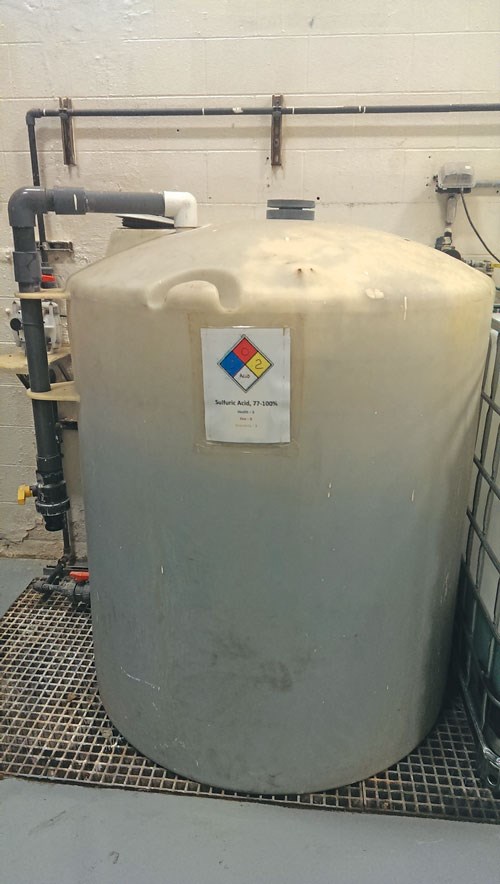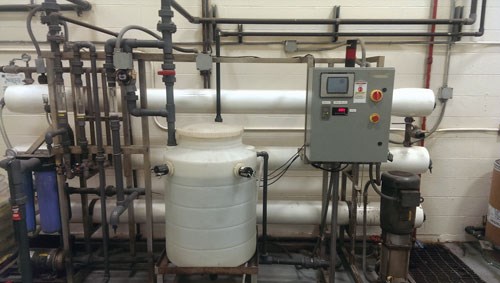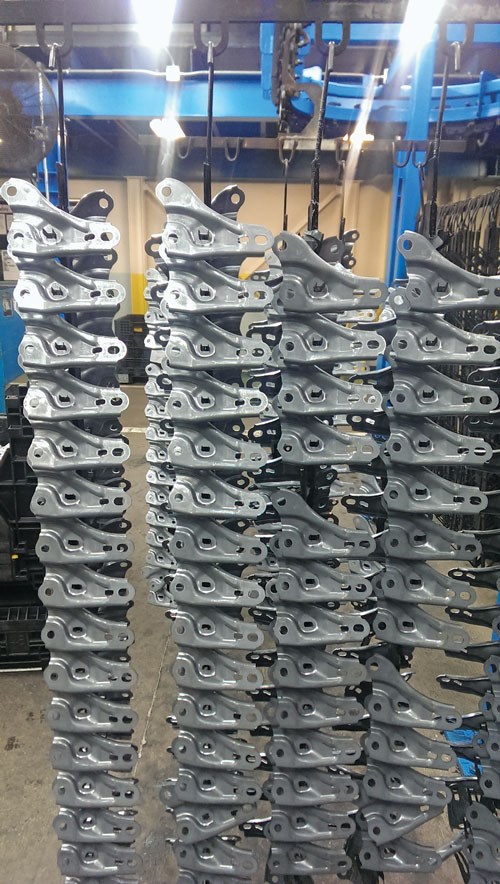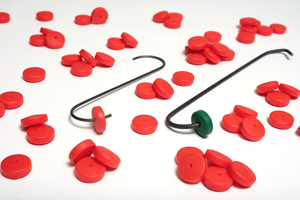Excellence in Electrocoating
How one shop’s line improvements cut expenditures by $400,000 per year.
The economic conditions of the past few years have been brutal to the automotive electrocoat industry, especially for captive shops like F&P America.
F&P (Troy, Ohio) is an international automotive systems supplier. Its roots started with parent company F-Tech in Saitama Prefecture, Japan, which was established in 1947 as a manufacturer of metal toys. In 1959, its relationship and initial business with Honda Motor Co. began when it started manufacturing motorcycle parts, eventually entering into automotive manufacturing as a Tier-One supplier for Honda.
To be a global partner with Honda, F-Tech expanded into North America in 1986, building its first plant in Canada. As demand for automotive parts increased, an additional plant in Ohio was needed.
Today, F&P America has approximately 1,000 quality-minded associates working together to serve such clients as Honda, Toyota and General Motors. The company’s line improvements—investments introduced into the system to make electrocoating operations more profitable—have cut expenditures by $400,000 per year.

Most chemical suppliers often provide shops with mini-bulk tanks
Improving the Bottom Line
Improving electrocoat systems is critical for all plants to stay competitive; F&P’s customers are constantly asking for 5 to 10 percent cost reductions. The one way this can be accomplished is by continual efficiency improvements to existing equipment, making it more cost effective.
There are many ways to reduce spending based solely on equipment. F&P found that the first place to look for improvements was in its overall budgets, before narrowing in on the most costly equipment. F&P’s approach was to look at all of its chemicals and work its way backwards, isolating equipment based on chemical consumption.
The following is a breakdown of different items that have potential for improvement. These are all actual projects with real data as they were performed at F&P to reduce costs and increase efficiency.
|
Table I: Transferring to a Mini-Bulk System |
|||
|
Chemical |
Before |
After |
Savings |
|
Calcium chloride |
$1.64 |
$1.43 |
13.0% |
|
Sodium hydroxide |
$6.38 |
$6.16 |
3.5% |
|
Nitric acid |
$3.92 |
$3.22 |
18.0% |
|
Sulfuric acid |
$4.05 |
$3.79 |
7.0% |
F&P realized an average savings of 10.36 percent, or $6,705, in profit, with only a small labor investment.
|
Table II: Wastewater Treatment Upgrades |
||
|
WWT Costs |
Old Costs |
New Costs |
|
Coagulant |
$78,672 |
$39,325 |
|
Sodium hydroxide |
$37,440 |
$6,236 |
|
Sulfuric acid |
$6,810 |
$3,575 |
|
Labor/maintenance |
$14,300 |
$2,600 |
|
Anionic polymer |
$3,805 |
$1,508 |
|
Cationic polymer |
$0 |
$1,726 |
|
Sludge removal |
2,400 cubic yards |
1,680 cubic yards |
|
Trench cleaning |
$10,000 |
$0 |
|
Yearly total |
$151,027 |
$54,971 |
Transferring to a Mini Bulk
This improvement, actually geared solely at technician safety, resulted in cost savings. The initial goal was to reduce the likelihood of a chemical spill or worse injury due to constantly moving and transferring chemicals out of drums. Most commodity chemical suppliers will provide mini-bulk tanks to achieve this at no charge; some will amortize it over a 6–12 month period so that there is no initial investment—this is how F&P made this improvement.
Most of a plant’s commodity chemicals are used in its wastewater treatment system, so the goal is to reduce costs, since all of that money goes down the drain anyway. Contact a chemical supplier and let it know your intentions; if it is a good supplier, it will work with you. F&P decided to use a mini-bulk set-up to reduce costs on these chemicals. In most cases, plants are already using chemical feed pumps, so the investment is nearly zero. In F&P’s case, the only up-front cost was in 10 additional internal labor hours to set up the system.
As illustrated in Table I, F&P realized an average savings of 10.36 percent back in profit, with a savings of $6,705, with hardly any investment at all.

With material costs of $900 and $1,000 in labor costs, F&P's ROI was less than one month after reusing spent Ro/Di.
Reusing Spent RO/DI Water
This is good water that is typically 25–30 microsiemens. It usually goes to the drain and then wastewater treatment, at which point plants spend more money to treat it and send it to the city sewer system, which is bad all around. What F&P did to improve this situation is simple: It installed piping coming directly out of the last RO stage (where the last RO stage would have sent the water to drain) and installed a valve and piping directly off of the pump. This pressurizes the plumbing at a rate comparable to city water.
F&P then installed that plumbing into its existing rinse water city water overflows. The company has flow meters to regulate flow at about 5 gallons per minute per rinse stage. With three rinse stages like this, the water savings are 15 gallons per minute.
Here’s the math: Usage is 15 gal./min., so 15 gal./min. × 60 = 900 gal./hr. 900 gal./hr. × 24 = 21,600 gal./day. In a year, that means 21,600 gal./day × 300 working days per year = 6,480,000 gal./year. With F&P’s cost per gallon at .0084, the company realized savings of $54,432. With material costs of $900 and $1,000 in labor costs, its ROI was less than one month.

F&P America is a Tier-One international automotive systems supplier with a large ecoat operation.
Shutting Dry-Off Oven
This project was also a no-brainer. F&P had a flash-off oven that just served to dry the parts prior to the e-coat tank. This piece of equipment is a huge waste in natural gas as well as electric.
The dry-off oven is a 1,000,000 Btu system that ran wide open whenever F&P was running production, consuming 240 therms per day, at a cost of $0.53 per therm. At 72,000 therms per year, that’s an annual cost of $38,160. Additionally, electric consumption was 346.6 kilowatts per day, and yearly consumption was 104,000 kilowatts at $0.067 per kilowatt at a cost of $7,000 per year.
Simply shutting down this piece of equipment eliminated both of these expenditures for a total savings of $45,160 per year and reduced the plant’s CO2 emissions by 616.2 metric tons in electric consumption, and 382 metric tons in natural gas usage, making the project quite green as well.
Costs for drip pans to catch water drippings from the final RO stage were $1,800 installed, so ROI was less than one month.
Wastewater Treatment Upgrade
A wastewater treatment upgrade is perhaps one of the most overlooked items due to the initial investment, but it can save big dollars if upgraded appropriately. The problem at F&P was that it was pushing so much process water to its wastewater treatment plant that the plant couldn’t handle it efficiently. The main purpose of a wastewater system in the e-coat industry is usually to precipitate out heavy metals so that the leftover water meets permit requirements to the local municipality. If it isn’t doing this effectively, a plant is throwing away money for an inefficient system.
This is the situation in most plants because, at a new plant start-up, no one likes spending money on a wastewater system. Most companies just purchase the minimum system to meet their needs. The problem arises several years later after several line modifications, when a plant has to increase its city water overflows in its rinses to maintain bath quality. In turn, because of the size of its holding tanks, it is forced to run the system faster than it was designed.
This is where the problem starts. To run the system faster, chemicals are turned up higher to make up for a lack of reaction time. This is what happened in F&P’s case, which led to a very unpredictable wastewater treatment system. It also becomes a maintenance nightmare because running the equipment beyond its capability wears everything out much quicker.
F&P investigated several different wastewater treatment systems to determine the best system with the capacity and flow rate it needed (85 gal/min). It found that most wastewater systems are pretty standard throughout the industry, so the risk was determined to be very minimal. The chosen system was purchased for $453,000 as a complete turnkey setup with estimated yearly operating costs of $65,000. Once the system was running, however, costs came in lower, around $55,000.
No new permitting was required because the system was considered an improved system of what the plant already had, incorporating nothing “new.” Table II shows actual dollars saved. Total savings per year was $96,056, and ROI on this project is 4.7 years. This is definitely a long-term investment, however; a standard wastewater treatment module has a life of 20 years, which means F&P could reap benefits for 15 years.
|
Table III: Converting from a DI Unit to an RO Unit |
|
|
DI Unit Yearly Operating Costs |
RO Unit Yearly Operating Costs |
|
Hydrochloric acid - $12,604 |
Electricity - $483 |
|
Sodium hydroxide - $35,650 |
Water to waste - $5,616 |
|
Labor/maintenance - $1,800 |
Cartridge filters - $576 |
|
Resin replacement - $8,300 |
Membranes - $792 |
|
Wastewater treatment - $30,900 |
Cleaners - $168 |
|
Sewer expense - $8,034 |
Labor/maintenance - $940 |
|
Water to waste - $1,656 |
Carbon - $1,503 |
|
Electricity - $70 |
Resin replacement - $570 |
|
|
Softener salt - $6,652 |
|
|
WWT cost - $0 |
|
|
Sewer expense - $6,739 |
|
Yearly total: $99,014 |
Yearly total: $24,040 |
Total reverse osmosis unit savings per year is $74,974 with an ROI of 8.5 months.
|
Table IV: Installing Variable Frequency Drives |
||||
|
|
Before |
After |
Difference |
Percent Savings |
|
KWH/year |
1,113,094 |
503,143 |
609,954 |
55% |
|
CO2 tons/year |
6,595.00 |
2,981.00 |
3,613.00 |
55% |
|
Data record/valve adjustment |
$6,712 |
$0 |
$6,712 |
100% |
|
Dollars/year |
$84,629 |
$35,220 |
$49,409 |
59% |
The VFD equipment and material cost was $40,000, and the savings per year was $49,409.
Converting from DI to RO
This improvement is easy. Because of the extensive costs associated with the unit, F&P decided it was time to upgrade. As anyone knows who has run a deionized (DI) water unit, though they often run great, they are also cumbersome. F&P performed the maintenance on this piece of equipment as called out in its manuals. However, once the resin beds were about a year old, chemical consumption would go through the roof, which, in turn, would increase wastewater and maintenance costs.
In many situations, F&P would run out of DI water, and the regeneration wouldn’t take, forcing the plant to regenerate again, costing more in chemicals. So F&P decided to upgrade to a more reliable reverse osmosis (RO) unit. RO units are the industry standard for most electrocoating operations, because they require very little attention as long daily checks are performed.
The plant purchased a complete turnkey unit for $78,000, and average total operating costs were less than $3,000 per month. This is one of the best pieces of equipment F&P has ever had in terms of cost and ease of use. Table III shows total RO unit savings per year of $74,974, with an ROI of 8.5 months.

VFD panel
Variable Frequency Drives
Installing variable frequency drives reduces voltage applied to the motor that, in turn, reduces motor RPMs. This enables the plant to control flow more effectively, using only the amount of energy needed for proper spray/agitation. This is a very green project as well. F&P was able to receive substantial rebates from the power company, which absorbed some of the costs of the project. It also reduced quite a bit of CO2 emissions.
In F&P’s situation, it was using outdated pumps with very low efficiency ratings. The company was constantly spending time adjusting valves to maintain proper flow—using more flow than necessary in paint stages, leading to foaming issues in the post rinses. The pumps were difficult to control flow to the nozzles if the in-tank risers were clogged or broken, and the quantity of water was never stable because of constant adjusting between shifts. The company had to look at different things to achieve all of its goals, which included HMI screens, transducers and alarms.
Table IV shows the results, which were a total variable frequency drive savings per year of $49,409, with equipment and material costs of $40,000. The ROI was less than one year.

VFD pendant
Paint Rack Efficiency
F&P’s previous system for loading and unloading small parts was slow with imperfect process yield. After investigating different paint rack styles, the company found a system called “spring racks,” which incorporate the use of spring steel to hold the part tightly and ensure proper grounding. This is important with very small parts that can lift off of the tooling during the e-coating process. F&P purchased equipment that clamps the spring rack together, enabling operators to easily place the parts on the rack and increase efficiency at the same time. This new system for the paint line decreased loading and unloading time, as well as improved process yield to 100 percent, and eliminated the need to add two positions.
Of course there are several other items that e-coaters can improve to further decrease expenses and increase profits:
Adding an amp hour replenishment system
Maintaining proper paint tooling cleaning/stripping
Installing a degreaser holding tank to reduce chemical waste during cleanings
A UF on degreaser stages to reduce chemical consumption.
These improvements saved F&P more than $400,000. Just remember that no improvement is too small. Pennies per day lead to thousands per year.
Jesse Taylor is with F&P America. Please visit fandp.com.
Originally published in the February 2016 issue.
Related Content
TTX’s Automated Conveyor Carrier System Offers Wireless, Flexible Operation
ACC system designed for reliable, consistent point-to-point movement of everything from small to heavy parts.
Read MoreConveyors and Paint Systems
Choosing the right conveyor system, coating technology, and ancillary equipment.
Read MoreCFS Unveils New Hook Locks Parts Racking Solution
New product from Custom Fabricating & Supplies (CFS) prevents part loss during coating processes.
Read MoreECOAT24 Attracts Both Serious Electrocoaters and Novices Alike
The conference, held April 2-4, 2024, in Orlando, Florida, provides the ecoating industry with educational sessions, supplier exhibits and networking with colleagues.
Read MoreRead Next
Education Bringing Cleaning to Machining
Debuting new speakers and cleaning technology content during this half-day workshop co-located with IMTS 2024.
Read MoreEpisode 45: An Interview with Chandler Mancuso, MacDermid Envio Solutions
Chandler Mancuso, technical director with MacDermid Envio discusses updating your wastewater treatment system and implementing materials recycling solutions to increase efficiencies, control costs and reduce environmental impact.
Read MoreA ‘Clean’ Agenda Offers Unique Presentations in Chicago
The 2024 Parts Cleaning Conference, co-located with the International Manufacturing Technology Show, includes presentations by several speakers who are new to the conference and topics that have not been covered in past editions of this event.
Read More













.jpg;maxWidth=300;quality=90)







